I’ve been running a successful painting business for over 15 years, and here are some tips I’d like to offer you, the homeowner, as you prepare to paint the exterior of your home.
If you are going to hire a professional, here are some things you can ask them about. Are these your standard practices? What items are included and what are extras? This will make a big difference in determining if the company you are considering is right for you.
If you’re planning a DIY project, here are some things you might consider doing yourself to extend the life of your paint job.
Colors: We recommend applying the colors you are considering on a cardboard backing (a long rectangular piece of cardboard). This will allow you to walk around your home and see colors in many light conditions. Once you have narrowed down the colors, it is recommended that a sample be applied to the wall for final approval. Please note that the color charts are misleading, the color often appears lighter once it is on the wall.
The standard gloss for exteriors is matte, while doors and windows are usually semi-gloss.
We do not recommend painting an existing light-colored stucco home with a dark paint color, as when things hit the stucco (such as placing trash bins against them), the stucco chips tend to fall off and the original lighter color fades. it will look bright.
We do not recommend red or black doors. Red paints have too much color and not enough stickum. The weatherstripping will often strip paint.
Pressure Washing – This is a quick rinse that usually takes an hour or two. Not all companies offer this, but it’s always a good idea to clean your house before applying paint. We suggest surrounding windows and doors to minimize leakage. Don’t forget to close your windows!
Protection: Remove dirt from around the house. In landscaped/lawn areas, we recommend masking/covering the grass. Cover everything! For delicate plants, wrap them individually in paper (make sure to uncover them as soon as you’re done to keep them alive and healthy!). Create a canopy around patio covers with protective clothing to keep spray and dust contained.
Preparation: Remove and replace rusted nails and gutter screws. Apply rust block to rusty items that cannot be replaced. Prime gutters, stucco patches, and raw wood.
Stucco Patches: First, patch stucco on any large pieces that are missing. Address large cracks after painting. This helps eliminate ugly texture differences that can often look worse than the original crack. Use masonry glue on the stucco for excellent adhesion.
Old garage doors with chalky oil: Sand, wash, prime, and convert oil finishes to water-based paint. Water-based paint is flexible and does not break down, becoming chalky like oil.
Caulking and back planing: Caulk loose joints where stucco meets wood around doors and joints in face boards, etc. Caulking under the eaves is a nice aesthetic touch, especially if you have a light color or white where your eyes can pick up blemishes quickly. Spray the paint onto the wood and under the eaves, then use a brush to push the paint into the cracks. Your trim should look like plastic impervious to water penetration. Thoroughly sand, prime the raw wood, seal any cracks, and keep applying coats of paint until smooth. (NOTE: caulking under the eaves is usually an extra because it is labor intensive)
Painting: Whenever possible, paint two sides of the house at the same time, that way you don’t cover all the windows at the same time.
Cleanliness: It’s always nice to come home to a clean interior, the same goes for your exterior. We do our best to pick up all of our paint chips before we leave, and that’s something that would make some businesses stand out from others. Also, while your painter is overhead, have him do a visual inspection of the roof for any broken tiles.
Wrought Iron – Paint the iron with oil, this should be done every few years, to keep on top of the rust and trap it before it turns chalky.
Price – Having your exterior professionally painted will usually cost you around $1.75/sqft, but there are factors that can change this, such as the amount of peeling paint, the density of plants around the house, whether you have wood windows, etc
Patio covers require a lot of preparation and painting. Most cost around $1000-$2000.
Wrought iron is around $40 per 10 foot section, per layer. The oil is usually just one coat because you do it every few years.
Estimated Completion Time: Most homes 2-4,000 square feet take 4-7 days. Depending on how big the team is at work.
Do you need to be there? Usually the only day the homeowner needs to be around is when the doors are being painted.
Follow up: Ask if the company you are considering will leave you a roll of masking tape to mark any touch ups and after 1 week or so they will take over again.
Keep in mind that with paint jobs and most services, you get what you pay for. We often see many homes that have overspray and poor to no prep work, resulting in peeling paint. If you want your home to look great for a longer period, time and money usually have to be spent.
